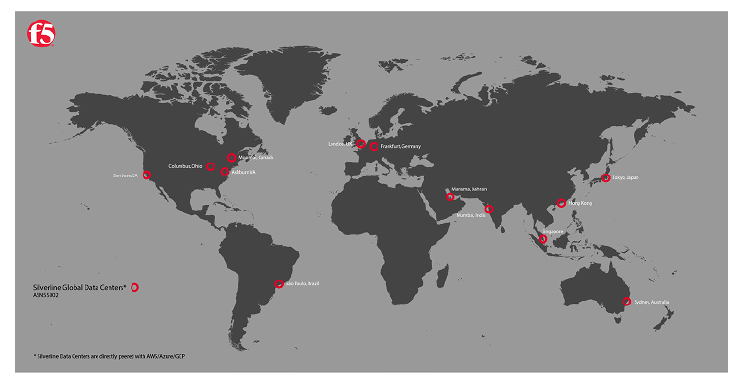Silverline Managed Services Platform을 콘텐츠 전송 네트워크와 통합
기업들은 끊임없이 변화하는 비즈니스 상황과 운영 환경에 어떻게 적응할 것인가에 대한 과제를 안고 있습니다. 비용 절감과 고객 만족도라는 두 가지 측면에서 즉각적인 운영 성과를 낼 수 있는 솔루션을 효율적이고 신속하게 구현하려면 내부 팀에서 내부적으로 정의된 목표를 달성하기 위한 최상의 솔루션을 선택할 수 있는 여유와 유연성이 필요합니다.
글로벌 IT 솔루션 제공업체인 당사 고객은 새로운 웹 콘텐츠 관리 시스템으로 전환할 때 다음과 같은 여러 가지 과제에 직면했습니다.
- 회사 웹사이트에서 최신 회사 콘텐츠를 가장 잘 관리, 홍보 및 배포하는 방법입니다.
- 고객이 지속적으로 인프라와 애플리케이션을 사용할 수 있도록 보장하는 방법입니다.
RFP 프로세스를 통해 고객은 여러 공급업체를 평가하여 보안과 성능의 최적 조합과 더불어 가장 포괄적인 콘텐츠 관리 전략을 제공하는 최상의 솔루션을 결정할 수 있었습니다.
이러한 프로세스를 통해 당사 고객은 기업 웹사이트에 게시되는 콘텐츠를 관리하는 매우 신뢰성 있고 안전하며 효율적인 네트워크를 구축하기 위해 여러 서비스를 결합하기로 결정했습니다.
당사 고객은 다음 요구 사항을 기반으로 솔루션을 구축했습니다.
- 전 세계의 잠재 고객과 기존 고객에게 콘텐츠를 배포하기 위해 여러 글로벌 에지 노드를 제공합니다.
- 주어진 글로벌 지역에 대한 로컬 요청을 2홉 미만으로 제한하기 위해 효과적인 로컬 BGP 경로를 제공합니다.
- 로컬 페이지 다운로드 요청 시간과 첫 번째 바이트까지의 시간을 로컬 호스팅 솔루션과 비슷한 시간 또는 그에 가까운 시간에 수행합니다.
- 관리형 웹 애플리케이션 방화벽, 네트워크와 애플리케이션 모두를 위한 관리형 DDoS 보호, 데스크톱과 모바일 기기를 위한 사기 및 봇 탐지 및 완화 서비스를 갖춘 안정성, 최적화 및 보안이 뛰어난 네트워크를 포함합니다.
- API 엔드포인트를 통한 자동화 및 마이크로서비스 배포, SIEM 통합, SSO 기능, 모든 포털 관리를 위한 역할 기반 액세스 제어를 통해 시스템을 관리하는 기능을 활성화합니다.
- IT 또는 다른 내부 팀의 개입을 최소화하여 내부 및 외부 참여자가 시스템과 쉽고 안전하게 상호작용할 수 있는 방법을 제공합니다.
솔루션의 투자 가치를 극대화하기 위해, 고객은 사용자 요청과 통합 용이성을 기준으로 가장 적절한 솔루션 비용을 제공하는 서비스를 선택했습니다. 또한 그들은 장기적으로 솔루션을 관리하는 데 필요한 리소스와 내부 콘텐츠 관리자와 기술 문서 작성자에게 미치는 영향도 고려했습니다.
전체 포트폴리오에서 일관된 경험을 제공한다는 목표를 달성하기 위해 당사 고객은 다음 제품과 서비스를 기반으로 아키텍처를 정의하고 선택했습니다.
관리형 보안 서비스
F5® Silverline 관리 서비스
-
웹 애플리케이션 방화벽
DDoS 애플리케이션 및 네트워크 보호
사기 / 자동화된 위협 / 봇 보호
API 시스템 관리 엔드포인트
SIEM 통합 SSO 기능
역할 기반 액세스 제어
경로 최적화
AWS, Azure, GCP와의 직접 피어링 관계
콘텐츠 관리
-
씨엠에스(CMS)
관리 서비스
콘텐츠 배포 및 저장
아마존 웹 서비스
-
아마존 EC2
아마존 ELB
아마존 루트 53
아마존 클라우드프론트
아마존 S3
웹 메트릭
분석 공급업체
-
사용자 분석
당사 고객은 완벽한 솔루션을 개발하는 데 가장 중요한 요소가 자사 고객에게 콘텐츠를 빠르게 전송하고, 귀중한 회사 자산과 지적 재산을 보호하는 보안, 장기적인 비용 절감 및 지속적인 서비스 가용성, 그리고 유지 관리 및 솔루션 관리 요구 사항 감소라는 것을 인식했습니다.
다음 다이어그램은 선택된 구성 요소를 기반으로 한 결합 솔루션의 아키텍처를 보여줍니다.
모든 조직의 우선순위는 고객에게 효율적으로 콘텐츠를 제공하는 것입니다. 저희 고객은 F5 Silverline과 AWS의 네트워크 피어링을 분석하여 고객이 지속적인 콘텐츠 및 서비스 가용성과 전 세계적으로 가장 빠른 브라우저 다운로드를 누릴 수 있는지 확인했습니다. AWS에 F5 Silverline 직접 피어링 연결을 도입한 덕분에 당사 고객은 성능과 콘텐츠 전송 측면에서 상당한 개선을 실현할 수 있었습니다. 그림 2와 3은 F5 Silverline과 AWS에 대한 글로벌 피어링 맵을 보여줍니다.
고객이 평가한 다른 솔루션과 비교해, 선택된 아키텍처는 상당한 비용 절감 효과를 제공합니다. 관리형 서비스를 이용하면 팀에서 시스템의 인프라와 보안 측면을 관리할 필요가 없습니다. 기고자들에게 원활한 게시 경험을 제공하는 데 집중하여, 대상 고객이 최신의 관련성 있는 게시 콘텐츠를 즉시 이용할 수 있도록 할 수 있습니다.
고객 경험은 항상 중요했습니다. 그러나 오늘날 전 세계적인 변화로 인해 고객이 정보를 소비하는 방법과 시기가 점점 더 큰 영향을 받고 있습니다. 조직은 고객의 변화하는 요구 사항을 이해하고 이를 중요하게 여긴다는 것을 보여주기 위해 이러한 변화에 신속하게 적응해야 합니다.
내부 운영, IT, 마케팅, 영업 및 엔지니어링 팀은 콘텐츠 소비에 있어서 마찰을 줄이고 일관되게 사용 가능하고 사용하기 쉬운 경험을 제공해야 하는 과제에 직면해 있습니다. 고객팀은 컴퓨팅 및 대역폭 리소스를 확장하는 데 있어 유연성이 뛰어나고, 두 아키텍처 모두 타사 구성 요소와의 신속한 통합이 가능하고, 지속적인 보안 및 위협 완화 기능이 있으며, 24시간 가용성이 유지되는 등의 이유로 F5 Silverline과 Amazon CloudFront를 선택했습니다. 이제 팀은 솔루션의 가장 중요한 구성 요소, 즉 사용자 참여를 촉진하는 가치 있고 관련성 있는 콘텐츠를 생성하는 데 집중할 수 있습니다.



